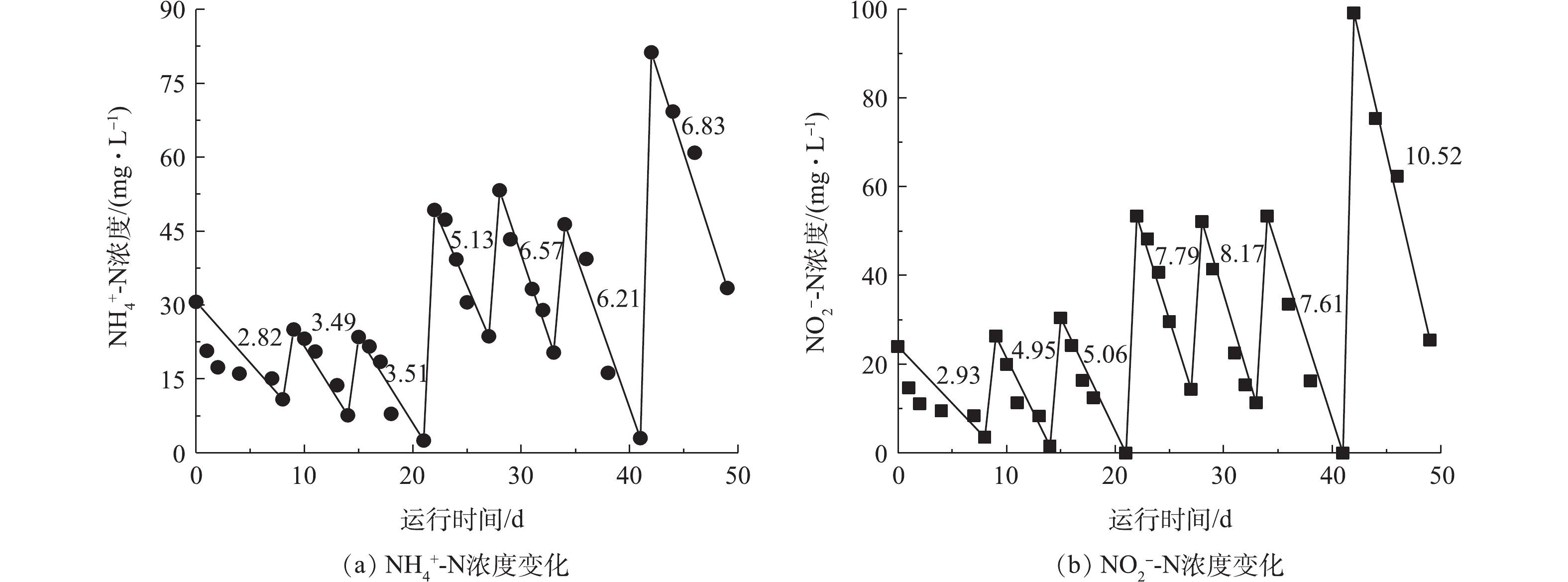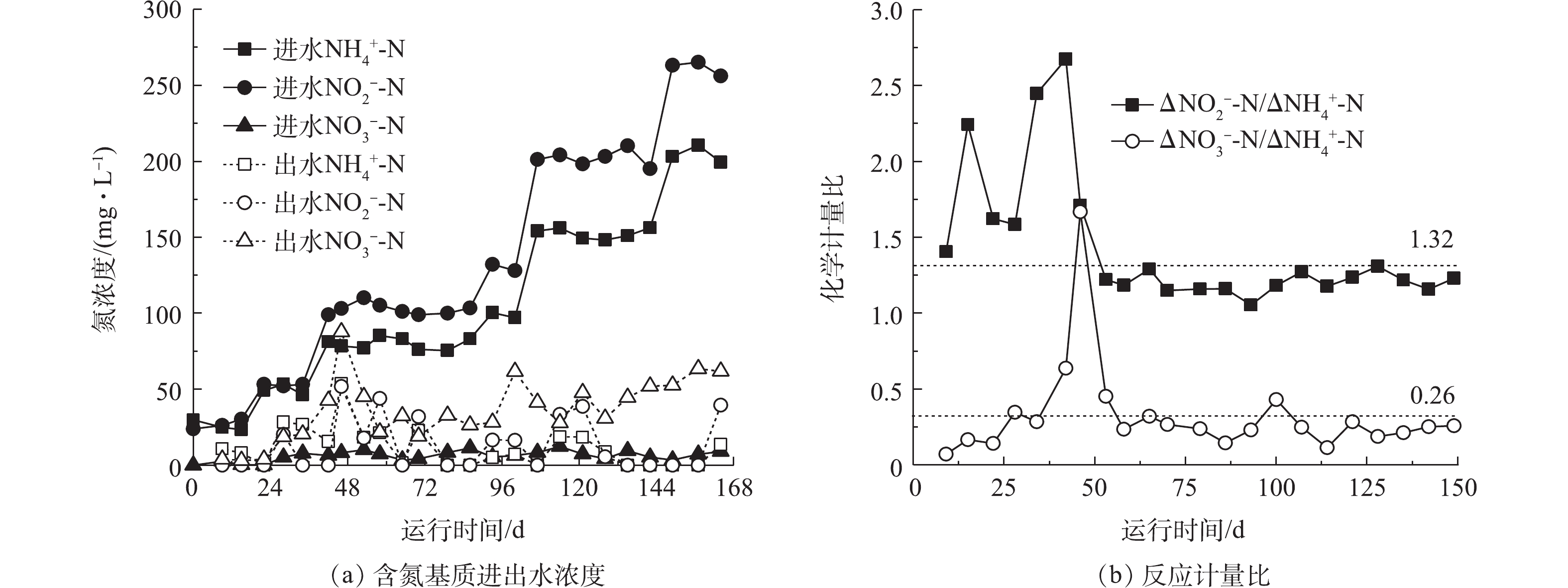-
厌氧氨氧化(Anammox)是一种高效节能的新型脱氮水处理工艺,主要通过将
${\rm{NO}}_2^{-} $ -N和${\rm{NH}}_4^{+} $ -N在厌氧条件下转化为氮气来减少废水中氮的含量。但厌氧氨氧化菌长达11~19 d的倍增时间使得厌氧氨氧化反应器启动时间过长,限制了其实现工程化应用。有研究表明,用传统的硝化污泥启动,整个周期过程长达6~24个月[1-2],而部分或全部使用厌氧氨氧化污泥接种可以使启动时间缩短到1~6个月[3-4],是快速启动Anammox工艺的首要选择。因此,Anammox工艺工程化需要重视厌氧氨氧化污泥种泥的保存问题,但长期保存会使污泥处于饥饿状态,从而对接种污泥的活性产生一定影响。饥饿状态下厌氧氨氧化污泥的活性和形态变化已有较多研究。黄佳路[5]发现,室温是污泥贮存的最佳温度,在室温无外源基质添加的存储条件下,厌氧氨氧化菌活性随保藏时间的延长而直线下降,储存到180 d的饥饿污泥恢复后,其比厌氧氨氧化活性仅为存储前的82.7%。汪彩华等[6]对4 ℃保存下的厌氧氨氧化污泥进行了研究,发现随保存时间的延长,污泥的颗粒结构会逐渐解体,保存到5个月时,混培物颜色变黑。由此可见,污泥形态和污泥储存有一定的相关性。颗粒污泥和絮状污泥的活性和其他特性均有较大差别,且这2种不同形态的厌氧氨氧化污泥在饥饿期后重新补加营养基质时的响应如何?饥饿后形态解体的污泥是否可以用作接种污泥启动厌氧氨氧化反应器?基于此,关于不同形态的厌氧氨氧化污泥对饥饿的响应问题还须进一步研究。
本研究将饥饿后的厌氧氨氧化絮状污泥接种到发酵罐,观察了启动所需时间及期间的活性和形态变化,同时通过批式实验考察了絮状和颗粒状厌氧氨氧化污泥对饥饿的响应规律,以期为长期保存下的厌氧氨氧化接种污泥的活性恢复和应用提供技术参考。
-
用5 L发酵罐(SBJX,上海连环生物工程设备有限公司)作为反应器,接种厌氧氨氧化污泥(来自柠檬酸厂的厌氧氨氧污泥,接种前在室温环境下保持饥饿状态15 d)。培养过程中进水
${\rm{NH}}_4^{+} $ -N、${\rm{NO}}_2^{-} $ -N初始浓度均为25 mg·L−1,逐步分别提高到200 mg·L−1和260 mg·L−1。其他营养物添加量为500 mg·L−1 KHCO3、27.2 mg·L−1 KH2PO4、300 mg·L−1 MgSO4·7H2O、155 mg·L−1 CaCl2。微量元素添加量为1 mL·L−1,组成为15 g·L−1 EDTA、9 g·L−1 FeSO4·7H2O、0.43 g·L−1 ZnSO4·7H2O、0.25 g·L−1 CuSO4·5H2O、0.19 g·L−1 NiCl·6H2O、0.014 g·L−1 H3BO4、0.24 g·L−1 CoCl2·6H2O、0.99 g·L−1 MnCl2·4H2O、0.22 g·L−1 NaMoO4·2H2O、0.21 g·L−1 NaSeO4·10H2O。 -
为了考察不同形态污泥对饥饿的耐受能力,首先进行常规培养(批次1):取反应器泥水混合液静置,弃去上清液后,分别收集絮状污泥和颗粒污泥,去离子水洗涤后制备成50 mL的污泥悬液备用;以50 mL血清瓶作为反应瓶,装入40 mL营养液并分别接种10 mL上述絮状/颗粒污泥悬液,再用氩气曝气2 min后封瓶,置于35 ℃恒温箱避光培养8 d;以不接种污泥的空白液作为对照,每组设置3个平行。批式实验培养基中NH4Cl 60 mg·L−1、NaNO2 60 mg·L−1,其余常量和微量元素配方同上。
反应结束后,设置10 d不加营养液的饥饿期,最后再次进行常规培养,重复3个批次(批次2~批次4),考察不同形态污泥的活性恢复情况。
-
利用纳氏试剂分光光度法测定
${\rm{NH}}_4^{+} $ -N[7];离子色谱仪(ICS 900,美国戴安)测量${\rm{NO}}_2^{-} $ -N和${\rm{NO}}_3^{-} $ -N;利用重量法测定污泥VSS浓度[7];比厌氧氨氧化活性(specific anammox activities,SAA)根据文献中的方法[6]测定;利用体式显微镜(LEICA S8AP0,徕卡仪器有限公司)观察污泥形态[8]。 -
1)絮状污泥反应器颗粒化过程。图1为反应器启动运行50 d内
${\rm{NH}}_4^{+} $ -N和${\rm{NO}}_2^{-} $ -N浓度的变化过程。初始培养时,进水${\rm{NH}}_4^{+} $ -N、${\rm{NO}}_2^{-} $ -N均为25 mg·L−1,到50 d时已逐步分别提高至80 mg·L−1和104 mg·L−1。接种的厌氧氨氧化污泥为饥饿后解体的絮状污泥,初期反应器的基质消耗速率较低,总氮去除速率仅为14.39 g·(m3·d)−1;随着基质浓度的提高,基质消耗速率也逐步增加(如图1中标识线段斜率所示),反应器总氮的消耗速率逐步增加至51.88 g·(m3·d)−1。运行前期,${\rm{NO}}_2^{-} $ -N的去除速率比${\rm{NH}}_4^{+} $ -N的去除速率要高,这表明反应器前期仍然发生了反硝化过程。反应器启动未添加有机碳源,部分异养菌死亡裂解释放的有机物可供反硝化菌利用[9]。而随着时间的延长,${\rm{NO}}_2^{-} $ -N和${\rm{NH}}_4^{+} $ -N消耗比率逐渐增大,这说明厌氧氨氧化菌群浓度逐步增加。随着反应器的长期运行,污泥逐渐发生了颗粒化,
${\rm{NH}}_4^{+} $ -N和${\rm{NO}}_2^{-} $ -N去除率稳步提升(见图2(a))。图2(b)为反应器启动及颗粒化过程中Δ${\rm{NO}}_2^{-} $ -N/Δ${\rm{NH}}_4^{+} $ -N的变化。反应器启动时厌氧氨氧化现象不明显,Δ${\rm{NO}}_2^{-} $ -N/Δ${\rm{NH}}_4^{+} $ -N比值高于1. 32,而Δ${\rm{NO}}_3^{-} $ -N/Δ${\rm{NH}}_4^{+} $ -N低于0. 26,这说明有反硝化菌参与反应。此阶段反应器内部厌氧氨氧化作用弱于反硝化作用。反应器内脱氮功能微生物种类较多,可能有Anammox菌、氨氧化细菌(ammonium-oxidising bacteria, AOB)、亚硝酸盐氧化菌(nitrite-oxidizing bacteria, NOB)、反硝化细菌(denitrifying bacteria, DNB)等。因此,运行前期50 d内的Δ${\rm{NO}}_2^{-} $ -N/Δ${\rm{NH}}_4^{+} $ -N与Δ${\rm{NO}}_3^{-} $ -N/Δ${\rm{NH}}_4^{+} $ -N的比值没有规律性变化。随着反应器运行时间的延长,厌氧氨氧化菌逐渐成为优势菌种,但依然存在氨氧化细菌,从而导致氨的额外消耗,此时,Δ${\rm{NO}}_2^{-} $ -N/Δ${\rm{NH}}_4^{+} $ -N略低于理论值1.32,Δ${\rm{NO}}_3^{-} $ -N/Δ${\rm{NH}}_4^{+} $ -N略低于理论值0.26。但在80 d后,两者的实际值已经非常接近理论值,且此时基质去除率稳定达到100%左右,故可认定厌氧氨氧化反应器启动成功[10]。反应器运行160 d后,进水${\rm{NH}}_4^{+} $ -N和${\rm{NO}}_2^{-} $ -N分别达到200 mg·L−1和260 mg·L−1,总氮容积去除速率为150.90 g·(m3·d)−1,此时污泥以颗粒态形式存在,活性显著高于启动阶段的絮体状态污泥。对比张龙等[11]的研究,直接用厌氧氨氧化混培菌接种反应器在60 d左右即完成启动,比本研究的启动时间提前了约20 d,这说明饥饿后的厌氧氨氧化种泥会在一定程度上延迟反应器的启动。2)絮状污泥颗粒化过程表征。图3为污泥颗粒化过程中不同阶段的形貌。经过约160 d的培养,污泥颗粒粒径由最初的0.2 mm左右生长到1 mm左右。接种污泥逐渐由棕黄色絮状污泥转变成暗红色颗粒污泥和棕色颗粒污泥的混合絮状污泥。接种污泥中仅存在少量的红色厌氧氨氧化菌,被包裹于透明絮体内(图3(a))。而随着颗粒化的进行,逐渐聚集形成颗粒污泥(图3(b))。反应器持续运行200 d后,形成以红色厌氧氨氧化菌为主的颗粒污泥。通常颗粒粒径不会无限制增加,主要是因为颗粒内部通常存在空腔。这是由于基质不足引起颗粒内部细胞自溶造成的,此类颗粒污泥容易被反应器内的紊动水流破碎,这些碎片成为新颗粒污泥的内核[12]。絮状周围包裹的物质可能是胞外多聚物(图3(c)),这是絮状污泥实现颗粒化的重要原因之一[5, 13];图3中厌氧氨氧化颗粒形状不规则,表面不平坦,主要表现为包裹在薄膜内的簇状粒子团的积聚形态,与ARROJO等[14]和TANG等[15]研究结果相似,同时符合已有研究[16]报道的厌氧氨氧化菌的形态。这些均表明成功培养出了厌氧氨氧化颗粒污泥。
-
不同形态污泥对饥饿的耐受能力的研究结果如图4所示。在批次1的正常培养中,颗粒污泥的SAA、去除率和平均反应速率明显好于絮状污泥。进行饥饿实验之前的絮状和颗粒状污泥的SAA分别为8.31 mg·(g·d)−1和17.71 mg·(g·d)−1,而饥饿期结束后,第1批的絮状和颗粒状的SAA分别达到了21.56 mg·(g·d)−1和24.38 mg·(g·d)−1,
${\rm{NH}}_4^{+} $ -N和${\rm{NO}}_2^{-} $ -N的去除率也由44.3%和44.5%分别上升到95.9%和92%,絮状污泥的反应速率上升速度高于颗粒污泥(图4(a)~(c))。这可能是由于絮状污泥对基质消耗速率较慢,因此,相同饥饿时间下活性保存时间比颗粒污泥更长,使得在第1次恢复培养时,絮状污泥的反应速率要高于颗粒污泥。批式实验中的Δ${\rm{NO}}_2^{-} $ -N/Δ${\rm{NH}}_4^{+} $ -N和Δ${\rm{NO}}_3^{-} $ -N/Δ${\rm{NH}}_4^{+} $ -N远低于连续运行的结果(图4(d)),这可能是由于基质浓度较低、微生物接种量较少以及传质性能不佳等因素所致。相对较高的${\rm{NH}}_4^{+} $ -N消耗量可能是由于其他氨氧化微生物的参与造成的。2015年,DAIMS等[17]和KESSEL等[18]同时发现了全程硝化菌(complete ammonia oxidizer, Comammox),且提出了氮循环的新路径。Comammox拥有氨氧化功能和亚硝酸氧化功能全套编码基因,能够进行从铵到硝态氮的单步完全硝化过程。而Anammox菌可以与Comammox共生,并且在低浓度下更容易生长[19]。本研究使用的絮状和颗粒状Anammox污泥中很可能也存在Comammox。此外,由于Anammox菌活性的衰减,死亡的菌体水解后可以作为碳源提供给反硝化菌,导致Δ${\rm{NO}}_3^{-} $ -N/Δ${\rm{NH}}_4^{+} $ -N低于理论值。结合图4(a)和图4(c),批次2的SAA和平均反应速率迅速上升,但批次3均有所下降,这说明在饥饿期,适应低营养环境的Comammox得到富集。因此,添加基质后,显示了较高的
${\rm{NH}}_4^{+} $ -N和${\rm{NO}}_2^{-} $ -N去除率。此时Anammox菌在饥饿期受到的损伤尚未恢复。批次3中${\rm{NH}}_4^{+} $ -N和${\rm{NO}}_2^{-} $ -N的去除速率下降是由于Comammox不适应较高基质培养的环境,Anammox菌低活性状态显现出来。此外,絮状污泥的SAA高于批次1结果,而颗粒污泥整体SAA甚至低于第1批絮状污泥。这可能是因为颗粒污泥活性较高,相等浓度初始基质下更早进入饥饿状态,使得颗粒中Anammox菌活性损伤高于絮状污泥。由批次4可以观察到,颗粒污泥的SAA开始回升到第1批状态,说明颗粒污泥的Anammox菌在第4批开始恢复,而絮状污泥Anammox菌活性较差,饥饿后恢复较慢,使得絮状污泥SAA依旧处于下滑趋势。因此,短期的饥饿条件下颗粒污泥的厌氧氨氧化菌恢复较强,而长时间的贮存可能会对厌氧氨氧化菌产生不可逆转的损伤,使得接种后反应器启动效率不高。有研究[20]表明,8个月长期存储下的颗粒污泥中微生物长期处于内源呼吸阶段,由于无法获得基质而死亡,颗粒污泥系统内整体活性降低并会部分解体,厌氧发酵产生了硫酸盐、甲烷、硫化氢等,使得污泥颜色变黑并产生臭鸡蛋味的刺激性气体。
-
1)用饥饿后解体成絮状的厌氧氨氧化污泥接种反应器可以在80 d内完成启动,160 d培养后,反应器完成颗粒化,总氮容积去除速率从初始的14.39 g·(m3·d)−1逐步提高到150.90 g·(m3·d)−1。颗粒化过程中,接种污泥由棕黄色絮状污泥转变成暗红色颗粒污泥和棕色颗粒污泥的混合,粒径由0.2 mm生长到1 mm左右,成功形成厌氧氨氧化颗粒污泥。
2)批式实验结果表明,厌氧氨氧化污泥颗粒的除氮效果优于絮状污泥,且经历10 d短期饥饿后,饥饿期污泥优势菌群可能会发生改变,但经过连续培养,可以在一定程度上恢复,恢复后颗粒污泥的活性要比絮状污泥更好。
饥饿对厌氧氨氧化污泥颗粒化及污泥形态的影响
Effects of starvation on granulation and morphology of Anammox sludge
-
摘要: 厌氧氨氧化颗粒污泥经过长期保存会逐渐解体成絮状,但目前关于保存后期的饥饿环境对不同形态污泥的影响尚缺乏深入研究。针对该问题,以饥饿15 d颗粒解体后的厌氧氨氧化絮状污泥作为接种污泥,考察了其颗粒化过程及其对于反应器启动和运行的影响,同时对比研究了絮状和颗粒状厌氧氨氧化污泥对于饥饿的响应及其活性恢复情况。结果表明:饥饿10 d后补料继续培养3个批次,厌氧氨氧化颗粒污泥反应活性的恢复速率高于絮状污泥;接种厌氧氨氧化絮状污泥80 d左右,反应器中
${\rm{NH}}_4^{+} $ -N和${\rm{NO}}_2^{-} $ -N的去除率均达到100%,160 d可以实现污泥的颗粒化。此研究结果可为利用长期保存下的种泥启动厌氧氨氧化反应器提供参考。Abstract: Anammox granular sludge will gradually disintegrate into floccus structure after long-term preservation, but the research on the effect of starvation on sludge with different forms at late stage of preservation is not sufficient at present. To solve this problem, this study focused on the start-up and granulation process of the reactor when Anammox floc sludge after 15 days starvation and granular disintegration was taken as inoculum, the responses of floc and granular Anammox sludge to starvation and their activity recovery were investigated. The experiment results showed that the reactivity recovery rate of Anammox granular sludge was higher than that of floc sludge after 10 days of starvation and continuous cultivation of three batches with addition of substrates. After about 80 days of Anammox floc sludge inoculation, the removal rates of both ammonia nitrogen and nitrous acid state reached 100%, and the sludge granulation could be realized within 160 days. The study provides reference for Anammox reactor start-up by using long-term preserved sludge.-
Key words:
- Anammox /
- granular sludge /
- floc sludge /
- granulation /
- starvation
-

-
-
[1] TAO W, HANMIN Z, FENGLIN Y, et al. Start-up of the Anammox process from the conventional activated sludge in a membrane bioreactor[J]. Bioresource Technology, 2009, 100(9): 2501-2506. doi: 10.1016/j.biortech.2008.12.011 [2] 李津, 于德爽. C/N比对Anammox与反硝化协同脱氮性能影响及其动力学研究[J]. 环境工程学报, 2016, 10(6): 2813-2818. doi: 10.12030/j.cjee.201503158 [3] MALAMIS S, KATSOU E, FRISON N, et al. Start-up of the completely autotrophic nitrogen removal process using low activity Anammox inoculum to treat low strength UASB effluent[J]. Bioresource Technology, 2013, 148: 467-473. doi: 10.1016/j.biortech.2013.08.134 [4] ALI M, OSHIKI M, OKABE S. Simple, rapid and effective preservation and reactivation of anaerobic ammonium oxidizing bacterium Candidatus Brocadia sinica[J]. Water Research, 2014, 57(5): 215-222. [5] 黄佳路. 厌氧氨氧化污泥的储存及活性恢复研究[D]. 哈尔滨: 哈尔滨工业大学, 2017. [6] 汪彩华, 郑平, 唐崇俭, 等. 间歇性饥饿对厌氧氨氧化菌混培物保藏特性的影响[J]. 环境科学学报, 2013, 33(1): 36-43. doi: 10.11654/jaes.2013.01.006 [7] 国家环境保护总局. 水和废水监测分析方法[M]. 4版. 北京: 中国环境科学出版社, 2002. [8] 彭诚, 任涛, 段侪杰. 基于体视显微镜的立体视觉测量系统[J]. 清华大学学报(自然科学版), 2015,55(2): 223-230. [9] 张蕾. 厌氧氨氧化性能的研究[D]. 杭州: 浙江大学, 2009. [10] STROUS M M, KUENEN J G J, JETTEN M S M. Key physiology of anaerobic ammonium oxidation[J]. Applied and Environmental Microbiology, 1999, 65(7): 3248-3250. [11] 张龙, 肖文德. 厌氧氨氧化菌混培物的培养及上流式厌氧污泥床反应器运行[J]. 华东理工大学学报(自然科学版), 2005, 31(1): 99-102. doi: 10.3969/j.issn.1006-3080.2005.01.024 [12] 李建政, 张立国, 班巧英, 等. 好氧活性污泥在升流式厌氧污泥床反应器中的厌氧颗粒化过程及机制[J]. 科技导报, 2012, 30(36): 19-23. doi: 10.3981/j.issn.1000-7857.2012.36.001 [13] 唐崇俭, 郑平, 汪彩华, 等. 高负荷厌氧氨氧化EGSB反应器的运行及其颗粒污泥的ECP特性[J]. 化工学报, 2010, 61(3): 732-739. [14] ARROJO B, MOSQUERA-CORRAL A, CAMPOS J L, et al. Effects of mechanical stress on Anammox granules in a sequencing batch reactor (SBR)[J]. Journal of Biotechnology, 2006, 123(4): 453-463. doi: 10.1016/j.jbiotec.2005.12.023 [15] TANG C J, ZHENG P, MAHMOOD Q. The shear force amendments on the slugging behavior of upflow Anammox granular sludge bed reactor[J]. Separation & Purification Technology, 2009, 69(3): 262-268. [16] KUENEN J G. Anammox bacteria: From discovery to application[J]. Nature Reviews Microbiology, 2008, 6(4): 320-326. doi: 10.1038/nrmicro1857 [17] DAIMS H, LEBEDEVA E V, PJEVAC P, et al. Complete nitrification by Nitrospira bacteria[J]. Nature, 2015, 528(7583): 504-509. doi: 10.1038/nature16461 [18] KESSEL M A H J V, SPETH D R, ALBERTSEN M, et al. Complete nitrification by a single microorganism[J]. Nature, 2015, 528(7583): 555-559. doi: 10.1038/nature16459 [19] KITS K D, SEDLACEK C J, LEBEDEVA E V, et al. Kinetic analysis of a complete nitrifier reveals an oligotrophic lifestyle[J]. Nature, 2017, 549(7671): 269-272. doi: 10.1038/nature23679 [20] 董兴水, 王智慧, 黄学茹, 等. 硝化作用研究的新发现: 单步硝化作用与全程氨氧化微生物[J]. 应用生态学报, 2017, 28(1): 345-352. -






 下载:
下载:




